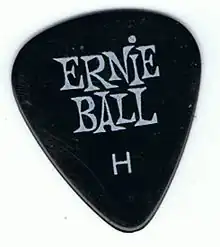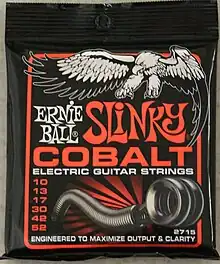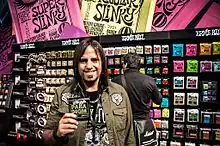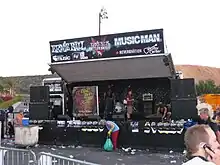Ernie Ball Inc.
Ernie Ball is an instrument and guitar accessory company based in San Luis Obispo, California. The brand was started by Roland Sherwood Ball in 1962 as a custom line of guitar strings. The company manufactures and sells guitars through Ernie Ball Music Man.
 Ernie Ball logo on a guitar pick | |
| Type | Private |
|---|---|
| Industry | Musical instruments |
| Founded | 1962 |
| Headquarters | San Luis Obispo, California, United States |
Area served | Global |
Key people | Ernie Ball Sterling Ball Brian Ball |
| Products | strings |
| Divisions | Music Man |
| Website | ernieball |
Background
Roland Sherwood "Ernie" Ball was a professional musician in Los Angeles and played guitar in the United States Air Force Band during the Korean War. In the 1950s, he began working as a studio musician and teacher.[1]
Sometime in 1957 or 1958, Ball opened what he claimed was the first music store in the United States to sell guitars exclusively, in Tarzana, California.[2] When music sales representatives criticized him for refusing to sell drumsticks and other musical equipment, Ball replied, "I just want to sell guitars." Within the next couple years he opened 2 other shops, one in Canoga Park, the other in Thousand Oaks.[3]
Brand beginnings

At his guitar store, Ball noticed that some younger players had difficulty bending the factory strings. He developed his own custom light gauge string sets and began selling them under the Ernie Ball brand in 1962. The lighter gauge strings and colorful packaging designed by Rolly Crump was successful with younger clients. These "slinky" strings went on to become popular with mainstream artists in the rock n' roll genre.[4]
Company growth

In 1967, Ball decided to focus solely on strings and guitar accessories, and moved the business to Newport Beach. In 1972, the company manufactured its first guitar; the Earthwood acoustic-electric bass.[4] Ernie Ball began producing a model in the early 1970s. His aim was to provide bass guitarists with a more acoustic-sounding instrument that would match better with the sound of acoustic guitars. Ball stated that "...if there were electric bass guitars to go with electric guitars then you ought to have acoustic basses to go with acoustic guitars." Ball said that "...the closest thing to an acoustic bass was the Mexican guitarron...in mariachi bands, so I bought one down in Tijuana and tinkered with it."[2]
Ball collaborated with George William Fullerton, a former employee at Fender, to develop the Earthwood. Production of this instrument ceased in 1974, resuming a few years later under the direction of Ernie Ball's employee Dan Norton, until production finally ended again in 1985. The Earthwood acoustic bass guitar was quite large and deep in contrast to most instruments in current production, which gave it more volume, especially in the low register. The Ernie Ball company describes Ball's design as "an idea before its time"; the instrument was little used in acoustic musical performances until the late 1980s, when the acoustic basses were used in performances on the MTV Unplugged television program.[2]
Sterling Ball, the son of Ernie, began working for the company at the age of 9. In 1973, he became a brand representative. In 1975, he was granted full control of the company.[4] In 1979, the company relocated to San Luis Obispo to increase production capabilities.[4]
In 1984, Ernie Ball acquired the guitar company Music Man. The deal included trademarks, inventory, and a warehouse, but no factory. A factory was built, and instrument production began in 1985.[4]
In 2000, Ernie Ball was raided by the copyright lobby group the Business Software Alliance and accused of having unlicensed software installed at its premises. Following a court settlement, the BSA used Ernie Ball as an example in advertisements and industry publications; Sterling Ball was so offended at this treatment that he had all Microsoft software removed from Ernie Ball ("I don't care if we have to buy 10,000 abacuses...") and imposed an open-source software policy across the company.[5]
In 2014, the company had 150 employees.[3] In 2015, Brian Ball, son of Sterling, was promoted to president of the company.[6] In 2019, he was made CEO.[7]
Ernie Ball Battle of the Bands

Since 1997, Ernie Ball has sponsored a battle of the bands at Warped Tour.[4] The event allows unsigned bands to compete for prizes and recognition on a prominent stage.[8] The competition has helped launch the career of bands such as PVRIS and Nothing More.[9]
Media
In 2016, Audience premiered Ernie Ball: The Pursuit Of Tone, a documentary series profiling popular guitar players and how they established their unique sound.[10]
Ernie Ball also publishes Ernie Ball: String Theory, a web series that discusses the origin stories of well-known musicians.[11]
References
- Music Trades, No. 9, Vol. 152; Pg. 177; ISSN 0027-4488: Ernie Ball; Deaths; October 1, 2004
- "History". Ernie Ball. Archived from the original on February 6, 2007. Retrieved 2014-03-24.
- Huff, Ryan (11 June 2014). "SLO man made name in guitar strings". San Luis Obispo Tribune. Retrieved 7 August 2023.
- Gill, Chris (16 September 2022). "60 years of Ernie Ball: the history of a family business that changed the world of guitar and bass as we know it". Guitar World. Retrieved 11 August 2023.
- Becker, David (20 August 2003). "Rockin' on without Microsoft". CNET. Retrieved 11 August 2023.
- Messitte, Nick. "As Music Sales Dwindle, Guitar Strings Thrive - A Profile Of Ernie Ball, Inc". Forbes. Retrieved 11 August 2023.
- "Ernie Ball announces Brian Ball as new CEO". Guitar World. 20 November 2019. Retrieved 11 August 2023.
- Van Pelt, Doug (13 March 2010). "Battle Of The Bands". HM Magazine. Retrieved 11 August 2023.
- Force, Sarah (21 April 2016). "Four artists that hit it big after competing in Ernie Ball's Warped Tour contest". Alternative Press Magazine. Retrieved 11 August 2023.
- "The Cult's Billy Duffy Featured On 'Ernie Ball: The Pursuit Of Tone'". Blabbermouth. 9 June 2016. Retrieved 11 August 2023.
- "Neal Schon: 5 things we learned from his Ernie Ball String Theory episode". Guitar World. 20 December 2019. Retrieved 11 August 2023.